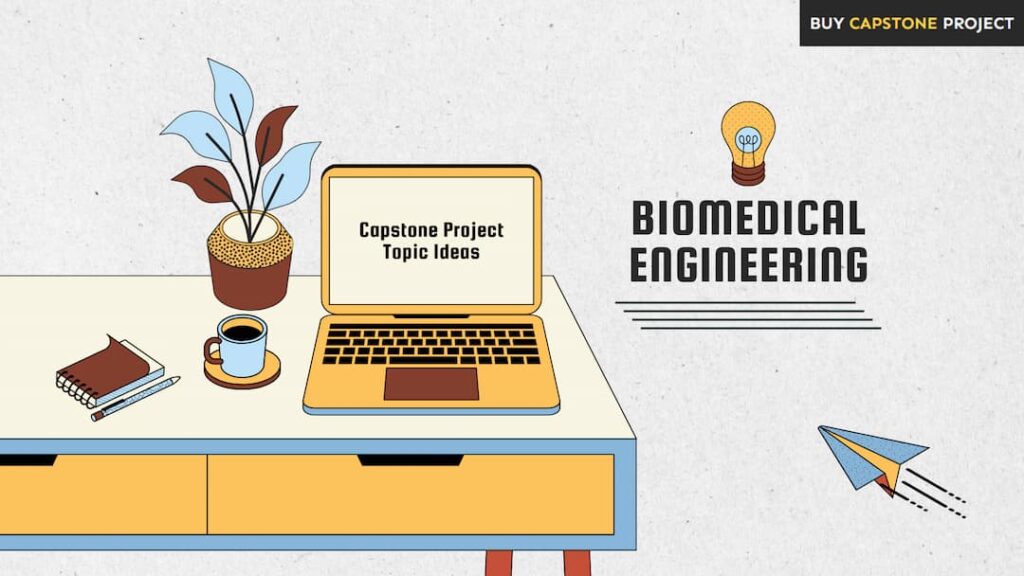Good Biomedical Engineering Topics for Your Capstone Project
1. Advanced Biomedical Imaging Techniques
Research Question 1:
How do recent improvements in MRI technology affect image resolution for early disease detection?
Overview: Compare technical specifications and clinical data to determine improvements in detecting small anomalies.
Research Question 2:
What role do contrast agents play in enhancing ultrasound imaging accuracy?
Overview: Review experimental studies and imaging reports to evaluate the effectiveness of various contrast agents.
Research Question 3:
How can machine learning be integrated with imaging data to improve diagnostic accuracy?
Overview: Analyze existing algorithms and test new approaches using image datasets to assess improvements in diagnostic decision-making.
2. Biomaterials for Tissue Engineering
Research Question 1:
How do different polymer scaffolds support cell growth in tissue engineering applications?
Overview: Compare in vitro cell culture studies on various polymer materials to identify optimal conditions for tissue regeneration.
Research Question 2:
What are the mechanical properties required for biomaterials in bone tissue engineering?
Overview: Review material testing data and conduct simulations to establish key strength and flexibility parameters.
Research Question 3:
How does surface modification of biomaterials enhance biocompatibility and integration?
Overview: Examine research on chemical or physical surface treatments and evaluate improvements in cell adhesion and tissue integration.
3. Wearable Health Monitoring Devices
Research Question 1:
How do sensor technologies in wearable devices improve real-time health monitoring?
Overview: Evaluate various sensor types and compare data accuracy from different wearable health devices.
Research Question 2:
What is the impact of wireless data transmission on the performance of wearable health monitors?
Overview: Analyze communication protocols and test device reliability in transmitting real-time health data.
Research Question 3:
How can machine learning algorithms enhance the interpretation of data from wearable sensors?
Overview: Develop and test data analysis models using sensor data to determine improvements in predictive health monitoring.
4. Neural Engineering and Brain-Computer Interfaces
Research Question 1:
How effective are non-invasive brain-computer interfaces in assisting patients with motor disabilities?
Overview: Compare clinical trial data to assess performance differences between various non-invasive interface technologies.
Research Question 2:
What signal processing techniques improve the accuracy of neural data interpretation?
Overview: Analyze different algorithms used to filter and interpret neural signals from EEG or MEG recordings.
Research Question 3:
How can advances in electrode materials improve the longevity and safety of implantable interfaces?
Overview: Review material science studies and test prototypes to identify materials that offer better biocompatibility and performance.
5. Biosensors for Disease Detection
Research Question 1:
How do electrochemical biosensors compare to optical biosensors in early disease detection?
Overview: Examine performance metrics from both types and analyze sensitivity, specificity, and response times.
Research Question 2:
What challenges exist in the miniaturization of biosensor platforms for point-of-care diagnostics?
Overview: Review current design limitations and propose potential solutions based on recent advancements in microfabrication.
Research Question 3:
How can integration of nanomaterials enhance the performance of biosensors?
Overview: Analyze the effect of nanomaterial coatings on signal amplification and detection limits using experimental data.
Hey, biomedical engineering fam, if your capstone is cranking up the stress with complex circuits and biotech puzzles, we’ve got your back. Let our squad handle the heavy lifting so you can kick back while we write your capstone project and make your work stand out!
6. Medical Device Design and Innovation
Research Question 1:
How does ergonomic design impact the usability of implantable medical devices?
Overview: Compare user feedback and performance data from devices designed with different ergonomic features.
Research Question 2:
What role do rapid prototyping techniques play in accelerating medical device development?
Overview: Evaluate case studies that use 3D printing or other prototyping methods to shorten design cycles and improve outcomes.
Research Question 3:
How can regulatory requirements be integrated into the design process of new medical devices?
Overview: Review current regulatory guidelines and interview industry experts to develop a framework for compliant design practices.
7. Bioprinting and Regenerative Medicine
Research Question 1:
How does the choice of bioink composition affect tissue viability in 3D bioprinting?
Overview: Compare experimental results using various bioink formulations and measure cell survival and function.
Research Question 2:
What advancements in bioprinting technology have the greatest potential to improve organ regeneration?
Overview: Review technological trends and evaluate case studies that demonstrate successful tissue or organ fabrication.
Research Question 3:
How can bioprinting techniques be optimized for creating vascularized tissue constructs?
Overview: Analyze research on vascular network formation and test printing parameters to improve nutrient delivery in engineered tissues.
8. Cardiovascular Device Engineering
Research Question 1:
How do new stent designs improve blood flow and reduce restenosis rates?
Overview: Compare clinical outcomes from different stent technologies using patient data and flow simulation models.
Research Question 2:
What materials and coatings contribute to the biocompatibility of artificial heart valves?
Overview: Review material studies and conduct biocompatibility tests to identify coatings that reduce the risk of thrombosis.
Research Question 3:
How can computational modeling assist in optimizing the design of cardiovascular devices?
Overview: Use simulation software to predict device performance under various physiological conditions and refine design parameters.
9. Rehabilitation Engineering and Assistive Technologies
Research Question 1:
How do exoskeleton designs enhance mobility in patients with spinal cord injuries?
Overview: Compare functional outcomes and user satisfaction from trials with different exoskeleton prototypes.
Research Question 2:
What role do sensor technologies play in developing responsive prosthetic devices?
Overview: Evaluate sensor integration and feedback systems in prosthetics to determine improvements in functionality and user control.
Research Question 3:
How can virtual reality environments be used to support physical rehabilitation?
Overview: Review experimental data and pilot studies to assess how VR-based interventions influence recovery speed and engagement.
10. Computational Modeling in Biomechanics
Research Question 1:
How do finite element models improve the prediction of stress distribution in orthopedic implants?
Overview: Develop computational models and compare simulation results with experimental data to validate implant designs.
Research Question 2:
What factors influence the accuracy of computational models in simulating human joint movement?
Overview: Analyze sensitivity studies and compare model outputs with motion capture data to identify key parameters.
Research Question 3:
How can patient-specific modeling enhance the customization of biomedical implants?
Overview: Use imaging data to create personalized models and evaluate how tailored designs improve clinical outcomes.
11. Drug Delivery Systems and Biomedical Devices
Research Question 1:
How do microfluidic devices improve the precision of drug delivery systems?
Overview: Compare controlled release profiles from microfluidic-based systems with conventional methods using lab data.
Research Question 2:
What are the key challenges in designing implantable drug delivery devices for chronic conditions?
Overview: Review case studies and experimental data to identify design constraints and propose engineering solutions.
Research Question 3:
How does the integration of biosensors enhance feedback control in drug delivery systems?
Overview: Analyze the performance of systems that combine sensing and delivery, focusing on accuracy and responsiveness.
12. Medical Signal Processing
Research Question 1:
How do advanced filtering techniques improve the interpretation of ECG signals?
Overview: Compare traditional and modern filtering methods using recorded ECG data to identify improvements in noise reduction.
Research Question 2:
What role does signal processing play in detecting early signs of cardiac abnormalities?
Overview: Develop and test algorithms that analyze ECG or other biosignals, focusing on early detection capabilities.
Research Question 3:
How can real-time signal processing be implemented in portable medical devices?
Overview: Review hardware and software integration techniques that enable fast processing while maintaining accuracy in portable devices.
13. Nanotechnology in Biomedical Applications
Research Question 1:
How do nanostructured materials improve targeted drug delivery?
Overview: Compare the performance of nanocarriers with traditional delivery methods by analyzing release profiles and targeting efficiency.
Research Question 2:
What are the biocompatibility challenges associated with nanomaterials in medical applications?
Overview: Review toxicity studies and conduct experiments to assess the safety of various nanomaterials in biological systems.
Research Question 3:
How can nanotechnology enhance imaging contrast in diagnostic procedures?
Overview: Evaluate the performance of nanoparticle-based contrast agents through experimental imaging studies and data analysis.
14. 3D Printing in Biomedical Engineering
Research Question 1:
How does 3D printing improve the production of patient-specific implants?
Overview: Compare case studies and production data to assess improvements in fit, function, and patient outcomes.
Research Question 2:
What are the limitations of current 3D printing technologies in fabricating complex biological structures?
Overview: Review technical literature and identify key challenges, suggesting potential technological improvements.
Research Question 3:
How can advances in bioprinting materials expand the capabilities of 3D printing in regenerative medicine?
Overview: Examine recent developments in bioinks and assess their performance in creating functional tissue constructs.
15. In Vivo and In Vitro Modeling of Diseases
Research Question 1:
How do engineered tissue models mimic the progression of specific diseases?
Overview: Compare experimental disease models with clinical data to validate the accuracy and relevance of engineered tissues.
Research Question 2:
What are the advantages and limitations of in vitro models compared to in vivo studies?
Overview: Analyze data from both model types to identify strengths and weaknesses in disease research applications.
Research Question 3:
How can advanced imaging techniques be integrated with tissue models to monitor disease progression?
Overview: Develop protocols that combine imaging data with tissue model observations to enhance real-time monitoring and analysis.
16. Bioinstrumentation and Medical Sensors
Research Question 1:
How do new sensor designs improve the detection accuracy of physiological parameters?
Overview: Compare data from innovative sensor prototypes with conventional sensors to evaluate improvements in sensitivity and specificity.
Research Question 2:
What are the challenges of integrating bioinstrumentation into wearable medical devices?
Overview: Review technical reports and case studies to identify design and integration issues, proposing methods to overcome them.
Research Question 3:
How can miniaturization of bioinstrumentation enhance point-of-care diagnostics?
Overview: Examine trends in device size reduction and analyze the impact on portability and diagnostic speed.
17. Regenerative Medicine and Stem Cell Engineering
Research Question 1:
How do scaffold designs influence stem cell differentiation in regenerative therapies?
Overview: Compare experimental data from different scaffold configurations to determine optimal conditions for cell differentiation.
Research Question 2:
What role does electrical stimulation play in enhancing tissue regeneration?
Overview: Review laboratory studies that test electrical stimulation protocols and analyze their effects on cell proliferation and tissue repair.
Research Question 3:
How can bioreactor systems be optimized for large-scale tissue engineering applications?
Overview: Evaluate existing bioreactor designs and simulate process parameters to improve scalability and efficiency.
18. Biomedical Device Integration with IoT
Research Question 1:
How does IoT connectivity enhance remote monitoring of implanted medical devices?
Overview: Compare system performance data before and after IoT integration to assess improvements in monitoring and maintenance.
Research Question 2:
What security challenges arise when integrating biomedical devices with IoT networks?
Overview: Review case studies and technical standards to identify vulnerabilities and suggest best practices for data protection.
Research Question 3:
How can real-time data from IoT-enabled devices improve patient outcomes?
Overview: Analyze patient monitoring data to determine how timely information leads to proactive treatment adjustments.
19. Computational Fluid Dynamics in Biomedical Applications
Research Question 1:
How do computational models predict blood flow patterns in cardiovascular devices?
Overview: Develop simulation models and compare results with clinical data to assess the accuracy of flow predictions.
Research Question 2:
What factors affect the hemodynamic performance of artificial heart valves in simulations?
Overview: Analyze parameter sensitivity in CFD models to identify key influences on blood flow and valve performance.
Research Question 3:
How can CFD be used to optimize the design of vascular grafts for improved patency?
Overview: Utilize simulation results to propose design modifications and test improvements in predicted flow dynamics.
20. Ethical and Regulatory Issues in Biomedical Engineering
Research Question 1:
How do current regulatory frameworks affect the development of novel biomedical devices?
Overview: Review policy documents and industry case studies to assess the impact of regulations on innovation and safety.
Research Question 2:
What ethical challenges arise from the use of emerging technologies in biomedical engineering?
Overview: Analyze ethical debates and case studies involving new devices or therapies to identify common concerns and potential resolutions.
Research Question 3:
How can biomedical engineers balance innovation with patient safety in device design?
Overview: Evaluate design processes and risk management strategies, proposing frameworks that integrate safety considerations without hindering progress.







